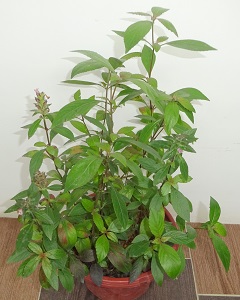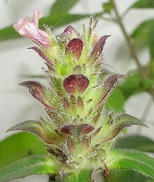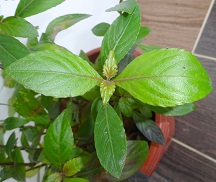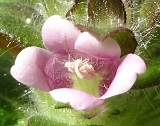| Home | Nature Weekly Index |
16 October 2016 | Green Shrimp Plant | Blechum pyramidatum |
 There is a relatively unknown herb cultivated in Singapore that goes by a Chinese name 夏枯草 or Self-heal in English. It is a
branched herb with upright flower spikes of green to dark maroon bracts and purplish pink flowers. The botanical name of
Self-heal is Prunella vulgaris. However, I doubt that this locally grown herb is actually Prunella vulgaris.
The real Prunella vulgaris has two-lipped flower resembling those of
Chinese Motherwort (Leonurus japonicus) while the flower shape of
the local herb resembled that from the
Black Face General (Strobilanthes crispa).
There is a relatively unknown herb cultivated in Singapore that goes by a Chinese name 夏枯草 or Self-heal in English. It is a
branched herb with upright flower spikes of green to dark maroon bracts and purplish pink flowers. The botanical name of
Self-heal is Prunella vulgaris. However, I doubt that this locally grown herb is actually Prunella vulgaris.
The real Prunella vulgaris has two-lipped flower resembling those of
Chinese Motherwort (Leonurus japonicus) while the flower shape of
the local herb resembled that from the
Black Face General (Strobilanthes crispa).

 My first encounter of this herb was in 2009 and it took me several years to narrow down its identity to the
Green Shrimp Plant (Blechum pyramidatum).
Blechum pyramidatum was mentioned in a
local publication
based on a flora survey done at the Upper Thomson Forest in 2012. However, no picture of this plant was shown
in the article. Another source that mentioned this plant was from a
blog posted in 2009 that sighted it
in Seletar area. However, the plant picture showed as Blechum pyramidatum in the blog should be
Nelsonia canescens (Blue Pussyleaf) instead. In a local plant
pictorial guide
(Plants in Tropical Cities)
published in 2014 (page 665), this local herb was again named as Prunella vulgaris.
My first encounter of this herb was in 2009 and it took me several years to narrow down its identity to the
Green Shrimp Plant (Blechum pyramidatum).
Blechum pyramidatum was mentioned in a
local publication
based on a flora survey done at the Upper Thomson Forest in 2012. However, no picture of this plant was shown
in the article. Another source that mentioned this plant was from a
blog posted in 2009 that sighted it
in Seletar area. However, the plant picture showed as Blechum pyramidatum in the blog should be
Nelsonia canescens (Blue Pussyleaf) instead. In a local plant
pictorial guide
(Plants in Tropical Cities)
published in 2014 (page 665), this local herb was again named as Prunella vulgaris.
 Pictures of the plant shown in the Internet typically had green floral bracts, which is probably why it is known commonly as
Green Shrimp Plant. The local version has dark maroon edge floral bracts. Hence, its identity may need further
investigation.
Pictures of the plant shown in the Internet typically had green floral bracts, which is probably why it is known commonly as
Green Shrimp Plant. The local version has dark maroon edge floral bracts. Hence, its identity may need further
investigation.
To examine the plant closer, I brought a pot back from a plant nursery last Saturday. Based on the week long observation, the flower blooms in the late morning around 8 am and withered by the evening. The flowering schedule is similar to that of Red Flame (Hemigraphis reptans), one of the common resident at my potted area. I suspect the seed pod looked the same but yet to get hold of one from the new plant.
An unexpected outcome on this identity search was the identification of another mysterious plant --- Hemigraphis glaucescens.